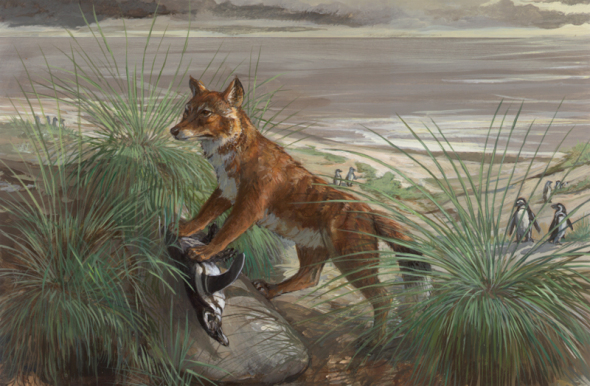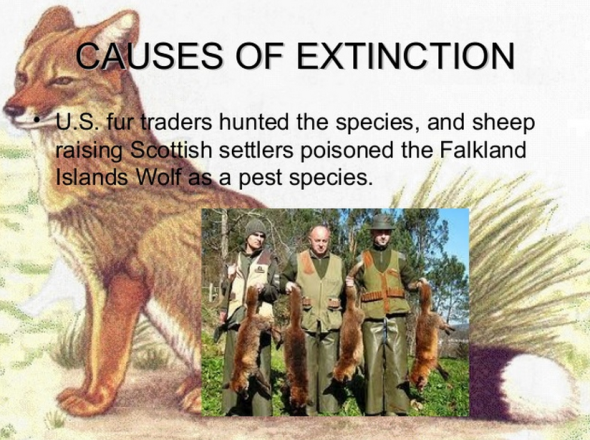Endangered Species Friday [Case Study]: Dusicyon australis
Endangered Species Friday [Case Study]: Dusicyon australis
How the Fur Trade Pushed the Falkland Islands Wolf into Extinction.
This Friday’s Endangered Species watch Post (ESP) focuses on a species that was literally hunted into extinction. Daily I read comments about our wildlife or speak to animal lovers, activists or conservationists of which many show great concern in relation to legal hunting E.g (Cites permitted trophy hunting), or poaching E.g (non-permitted illegal hunting).
D. australis was identified back in 1792 as the (Falklands Wolf) by Dr Robert Kerr (1755 – 11 October 1813) was a scientific writer and translator from Scotland. Dr Kerr was born in Roxburghshire as the son of a jeweler. He studied medicine at the University of Edinburgh and practiced at the Edinburgh Foundling Hospital as a surgeon. He translated several scientific works into English, such as Antoine Lavoisier’s work of 1789, Traité Élémentaire de Chimie, published under the title Elements of Chemistry in a New Systematic Order containing All the Modern Discoveries, in 1790.
In 1792, Dr Kerr published The Animal Kingdom, the first two volumes of a four-tome translation of Professor Linnaeus’ Systema Naturae, which is often cited as the taxonomic authority for a great many species. (He never did the remaining two volumes.) What would Dr Kerr say now if he knew this magnificent creature he discovered has since been pushed into extinction via ‘legal hunting practices and deliberate persecution’?. Like few conservationists and philanthropist’s that I have spoken to whom have identified species of birds, frogs and new world primates their most common reaction is utter shock and frustration, although most were not surprised.
While Dr Kerr was the primary individual that named and listed the species, Capt. John Strong, a British Marine explorer was the very first person to discover the Falkland Island Wolf upon landing on the Falkland Islands back in the 1690’s. Based on historical and fossil records we know the species was living quite a peaceful and undisturbed life. Historical records also prove that Charles Darwin who was a naturalist and geologist whom visited the islands back in 1833 stated the Falkland’s Wolf was commonly seen. Its from this point back in the early 1800’s after Charles Darwin’s visit that the Falkland Wolf populations began to decline. Within approximately thirty years after Charles Darwin’s visit - the species then went extinct.
From 1833 to 1876 when active exploration’s and colonization’s began increasing the evidence pinpoints that humans were the primary cause for the species complete extinction. Had the Falkland’s not been colonized or disturbed by explorers and hunters its very likely the Falkland Islands Wolf would still be with us today. That is based on my own expert opinion and scientific studies that have proved islands with no human interference over eighty million years old up to the 1900’s the majority of non-colonized islands regardless of their size - all their natural wildlife discovered is still mostly intact. Take the island of Madagascar as an example!
The prehistoric breakup of the supercontinent Gondwana separated the Madagascar-Antarctica-India landmass from the Africa-South America landmass around 135 million years ago. Madagascar later split from India about 88 million years ago, allowing plants and animals on the island to evolve in relative isolation. As a result of the island’s long isolation from neighboring continents, Madagascar is home to an abundance of plants and animals found nowhere else on Earth. Approximately 90 percent of all plant and animal species found in Madagascar are endemic. So we know that if left untouched both the Falkland island and Madagascar’s habitat and wildlife both flora and fauna lived undistributed.
While Madagascar’s history is a little different from the Falkland Islands the evidence is clear, that as soon as explorers, human colonies, immigrants and travelling settlers visited - the habitat became threatened just as the Falkland’s Wolf became extinct in under thirty years after Charles Darwin’s visit, 1833. Only 10 percent of Madagascar’s forests now remain. Also, recent estimates suggest that 1-2 percent of Madagascar’s remaining forests are destroyed each year, and that a staggering 80-90 percent of Madagascar’s land area burns each year. Ninety percent of Madagascar’s Lemurs are moving towards complete extinction - and why? from 700 CE – 1500 when immigrants, traders and explorers arrived - wildlife and habitat began to decline gargantuanly. However based on historical fur trade records a pattern has emerged - its concerning - its continuing - and if not banned its likely other animals will suffer due to the fur trade.
“Our ancestors are not to blame”
But lets not jump the gun here blaming our own ancestors for the primary decline of wildlife and destruction of habitat. As Charles Darwin explained in the 1830’s on visiting the Malvina the Falkland Wolf was still quite commonly seen. Just as Lemurs and forest remained intact on the island of Madagascar before humans arrived, history tells us though that our ancestors mostly respected the land and wildlife however, its from years of 1800 that wildlife and habitat began declining. The Falkland’s Wolf wasn’t killed off by our ancestors as such but more - US fur traders from the 1830s, and when Scottish settlers arrived in the 1860s began raising sheep on the Island, D. australis was poisoned as a pest species too.
Is it just a mere coincidence that the Falkland Islands Wolf went extinct as soon as the fur trade began booming from the 1600’s to the 1800’s dare I ask? commercial fur trade in North America grew out of the early contact between Indians and European fisherman who were netting cod on the Grand Banks off Newfoundland and on the Bay of Gaspé near Quebec. Indians would trade the pelts of small animals, such as mink, for knives and other iron-based products, or for textiles. Exchange at first was haphazard and it was only in the late sixteenth century, when the wearing of beaver hats became fashionable, that firms were established who dealt exclusively in furs. The trade then spread to America thus seeing United States citizens hunting the Falklands Wolf into extinction. So again I question is it correct to blame our ancestors whom colonized the Falkland Islands of which Darwin stated the wolf was still commonly seen from 1830, bur more blame Canadians, Americans and Europeans for the introduction of the fur trade? That’s the problem, not colonization or immigration but sheer commercialization of an animal trade and greed.
There are some other factors of course that relate to the Falkland’s Wolf extinction. The species natural prey which was rodents were in decline too. Due to the decline of certain prey specimens this unfortunately forced the wolf into now human populated agricultural lands, hunting sheep. The Falkland’s Wolf was then seen as a pest of which settlers, mainly farmers deliberately laid poisoned traps thus decreasing populations furthermore. Its believed that the decline in rodents was primarily due to humans protecting their farms and crops. None knows for sure the entire Falkland’s Wolf diet but - ground-nesting birds such as geese and penguins, grubs and insects, as well as seashore scavenging would most likely have been common prey and foraging behavior.
Conclusion:
The Falkland’s Wolf was killed off by greed, legal hunting and the fur trade. Its quite sad to know that after Darwin’s notes were made public the species soon became extinct some thirty years later, had them notes not been publicized - the species could still be with extant. While we have certain protocols, laws and agreements in place such as the Convention on International Trade of Endangered Species (Cites), and the International Union for the Conservation of Nature - history is still repeating itself, so I do at the best of times question why we have such organisations in place to protect wildlife - when its “we humans” that should be taking the stand and protecting what is left on Planet Earth. While poaching remains a significantly large threat to many large fauna such as Lions, Elephants, Rhino and aquatic wildlife. The agricultural trade, indiscriminate hunting and habitat loss remains the number one threat to all species of flora and fauna.
So, how do we stop further extinctions and declines of wildlife? Well if you’ve read this entire article all the way through (the answer is in front of you).. You’ve just got to open your eyes, absorb the information and act on it.
Dr Jose C. Depre.
Environmental and Botanical Science.





Thank you for your reply, should it merit a response we will respond in due course. This site is owned by International Animal Rescue Foundation and moderation is used.